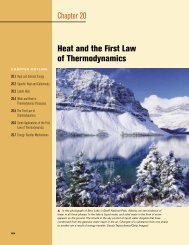15 • Oscillatory Motion - ECHSPhysics
15 • Oscillatory Motion - ECHSPhysics
15 • Oscillatory Motion - ECHSPhysics
Create successful ePaper yourself
Turn your PDF publications into a flip-book with our unique Google optimized e-Paper software.
oscillator is at the equilibrium position x 0. The magnitude of the acceleration is a<br />
maximum at the turning points and zero at the equilibrium position.<br />
The kinetic energy and potential energy for a simple harmonic oscillator vary with<br />
time and are given by<br />
(<strong>15</strong>.19)<br />
(<strong>15</strong>.20)<br />
The total energy of a simple harmonic oscillator is a constant of the motion and is<br />
given by<br />
(<strong>15</strong>.21)<br />
The potential energy of the oscillator is a maximum when the oscillator is at its turning<br />
points and is zero when the oscillator is at the equilibrium position. The kinetic energy<br />
is zero at the turning points and a maximum at the equilibrium position.<br />
A simple pendulum of length L moves in simple harmonic motion for small angular<br />
displacements from the vertical. Its period is<br />
(<strong>15</strong>.26)<br />
For small angular displacements from the vertical, a physical pendulum moves in<br />
simple harmonic motion about a pivot that does not go through the center of mass.<br />
The period of this motion is<br />
(<strong>15</strong>.28)<br />
where I is the moment of inertia about an axis through the pivot and d is the distance<br />
from the pivot to the center of mass.<br />
If an oscillator experiences a damping force R b v, its position for small damping<br />
is described by<br />
where<br />
(<strong>15</strong>.32)<br />
(<strong>15</strong>.33)<br />
If an oscillator is subject to a sinusoidal driving force F(t) F 0 sin t, it exhibits<br />
resonance, in which the amplitude is largest when the driving frequency matches the<br />
natural frequency of the oscillator.<br />
QUESTIONS<br />
K 1<br />
2 mv 2 1<br />
2 m 2A2 sin2 (t )<br />
U 1<br />
2 kx 2 1<br />
2 kA 2 cos2 (t )<br />
T 2 √ L<br />
g<br />
T 2 √ I<br />
mgd<br />
b<br />
<br />
x Ae 2m t cos(t )<br />
√ k<br />
E 1<br />
2 kA2<br />
m<br />
b<br />
2m 2<br />
1. Is a bouncing ball an example of simple harmonic motion?<br />
Is the daily movement of a student from home to school<br />
and back simple harmonic motion? Why or why not?<br />
2.<br />
If the coordinate of a particle varies as x A cos t,<br />
what is the phase constant in Equation <strong>15</strong>.6? At what position<br />
is the particle at t 0?<br />
3. Does the displacement of an oscillating particle between<br />
t 0 and a later time t necessarily equal the position of<br />
the particle at time t ? Explain.<br />
4. Determine whether or not the following quantities can be<br />
in the same direction for a simple harmonic oscillator:<br />
(a) position and velocity, (b) velocity and acceleration,<br />
(c) position and acceleration.<br />
Questions 475<br />
5. Can the amplitude A and phase constant be determined<br />
for an oscillator if only the position is specified at t 0?<br />
Explain.<br />
6. Describe qualitatively the motion of a block–spring system<br />
when the mass of the spring is not neglected.<br />
7. A block is hung on a spring, and the frequency f of the oscillation<br />
of the system is measured. The block, a second<br />
identical block, and the spring are carried in the Space<br />
Shuttle to space. The two blocks are attached to the ends<br />
of the spring, and the system is taken out into space on a<br />
space walk. The spring is extended, and the system is released<br />
to oscillate while floating in space. What is the frequency<br />
of oscillation for this system, in terms of f ?



